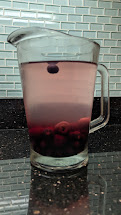Sourdough Starter
This week's recipe is a little different than usual. This is my fifth or sixth attempt at keeping a sourdough starter working. The first few attempts offered mixed results, but I learned from each one. Sourdough Starter is a commitment. That is the first thing anyone attempting to start a sourdough starter needs to understand. It's not something you only pay attention to when the mood strikes. It needs daily attention. My latest Sourdough Starter has been going strong for at least a year and a half now, maybe closer to two years. I don't remember exactly when I started it. That's the longest I've had one survive, but I know that I could easily kill it with just a few days of neglect.
Sourdough Starter
Water*
Patience
Persistence
Day 1:
2 cups organic whole wheat flour
2 cups water
Place flour and water together in a jar or canister with a loose lid. The
mixture needs air to do its work, so do not seal the lid. Stir mixture
together.
Day 2:
Remove and discard 1 cup of mixture
Add
1 cup
1 cup water
Day 3**:
Stir mixture.
Remove and discard 1 cup of mixture
Add
½ cup
½ cup water
Stir into mixture. Place lid loosely back on top. Set aside.
Day 4:
Remove and discard 1 cup of mixture
Add
1 cup
1 cup water
Stir into mixture. Place lid loosely back on top. Set aside.
Stir mixture.
Remove and discard 1 cup of mixture
Add
½ cup
½ cup water
Stir into mixture. Place lid loosely back on top. Set aside.
Day 6
Stir mixture.
Remove and discard 1 of cup mixture
Add
1 cup
1 cup water
Stir into mixture. Place lid loosely back on top. Set aside.
Keep repeating this process until mixture begins to take on a
sourdough-y smell. It will be reminiscent of sourdough bread but not quite.
This will likely take 1-2 weeks of alternating the flour/water additions. There
will likely be a point when the mixture overflows the container, so it’s good
to place a plate or bowl under the sourdough vessel. This rarely happens once the
sourdough starter is established. There is a bit of finesse to this process
because it requires watching and smelling the mixture and adjusting the amount
of flour based on the mixture’s behavior. There will be a time when it develops
a “liquor” – a layer of liquid on top – that will show you the process is
working. Stir it back in before removing that day's portion to discard and feed as normal.
Before you embark on creating a sourdough starter, understand you are
making a commitment. This isn’t project with an end date. To keep a sourdough
starter “alive”, it must be “fed” daily using the above process. And, again, it
takes a bit of finesse. You need to be able to see what is happening, smell what
is happening, and decide what approach to take.
I store my sourdough starter in my pantry with my other flours and baking ingredients. By keeping it there, I see it every day, but it's also not on the counter where it can be in the way.
When I travel, I feed mine and then place it in the refrigerator before
I leave. When I get back, I take it out of the refrigerator and then start to
feed it diligently again. It usually takes a week or so to get back to the
sourdoughiness we like.
Sourdough Starter isn’t difficult, but it can be tricky, and it does
require a commitment. Yet, if you mess up, guess what it’s easy to fix or start
over. If you miss a day or two, you can usually fix the starter. If you miss more
than two days, you might need to start over.
I’ve also discovered that what works best for me is to have two small
canisters I can switch between. That way if it overflows the container or I don’t
like the way it starts looking around the top of the container – it turns black or gross looking – I simply switch it to the other container and wash the dirty
container. This might not be the traditional way to handle it based on what I’ve
read, but sometimes you just have to do what works for you.
My husband makes sourdough bread most weeks, and I make sourdough pancakes occasionally. Now, that I'm confident with my sourdough starter, I plan to create some more recipes using sourdough starter.
*I prefer to use filtered water for this, but I'm fairly certain tap water would work fine. I have an RO System, so I use filtered water whenever possible.
** Day 3 was the day my starter overflowed this time. I took that as a good sign! It meant the starter was doing what it was supposed to do!! However, I do wish I'd put a plate under it to catch the overflow... Sighs! Oh, well! I normally would have probably moved it into another container at this point, but my other container had my long term starter in it.
Note: I use organic ingredients whenever possible.


















Comments
Post a Comment